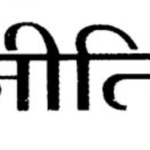
Recently, an Admiral of the Bharat Nau Sena discussed a strategic estimation of India:
“The Economist weekly, in a 2013 article titled “Can India Become a Great Power”, seemed to put its finger on the reason: “India has the world’s 4th largest military,” it said, “and yet its political class shows little sign of knowing or caring how the country’s military clout should be deployed.” Warning India against “an unstable but dangerous Pakistan and a swaggering and intimidating China“, it observed: “The absence of a strategic culture and the distrust between civilian-run ministries and the armed forces has undermined military effectiveness.”
This quote relies on a famous critique of India by Rand in the early 90s. While it is historically inaccurate, it nevertheless has a large kernel of truth in the present era.
The root of this lies in all theory-but-little-practice armchair chanakyas who over-emphasise the venerable Acharya Chanakya. Pure strategy in fact does not begin with his Arthasastra, but with Lord Krishna and Krishna Niti. This is because strategy is directly (not indirectly) connected with on the ground operations (institutional, military, covert, or overt). If you don’t have “skin in the game”, if you don’t have a track record of competence, you don’t count. The “Intellectual Yet Idiot” has no accountability if his theory fails. The general, the political leader, or executive does. It’s his neck that’s on the line.
Arthasastra is absolutely a foundational text on Indic Statecraft, and it is not that Strategy didn’t exist in it in some form. But Statecraft isn’t Strategy, and certainly not Pure Strategy. If Politics translates to Rajaniti, then Statecraft is connected to Arthasastra, because Arthasastra, like Soopa Sastra, means more than the literal translation. Arthasastra is translated as Science of Wealth but it is fundamentally a work of Political Economy and Statecraft. While there are elements of strategy and strategic education—just as there are in Panchatantra and Hitopadesa—it is not the same as Pure Strategy, which requires flexibility and asymmetric creativity rather than formulae and minutiae.
Sun Tsu’s Art of War is more a work of Pure Strategy than Statecraft, and the Arthasastra is the reverse. To understand Pure Strategy (Koota Niti in Sanskrit or Kruttik Niti in Shuddh Hindi), one must first understand its true definition: Winning or managing the competitive landscape by developing asymmetric advantages through long-term planning & application.
“Know yourself and Know your enemy and you will be victorious in a hundred battles”
To fathom China's strategy, read Sun Tzu: “Let your plans be dark and impenetrable as night, and when you move, fall like a thunderbolt.” pic.twitter.com/yf2esiKW4S
— Brahma Chellaney (@Chellaney) July 15, 2017
Asymmetry necessarily requires not only knowledge and competence, but also creativity and imagination: Deployment of small ships in the tight Salamis straits to defeat larger Persian triremes, the Roman corvus to defeat the Carthaginian navy, light cavalry and Maratha forts to ground down the pondering Mughals, and the Vietnamese tunnel system to tackle adversaries with air superiority. Such solutions are indeed given inspiration by historical study, but are nevertheless produced by application of imagination. That is the importance of competence, creativity, and courage in Strategic matters. Our current Kautilyas-wannabe lack all 3.
The Art of War does not list out every solution for every situation, but rather, provides the principles which inspire new solutions that fit the new situation. Most militaries (and armchair chanakyas) are busy fighting the last war, rather than developing the foresight to win the next one. This takes more than just memorisation of current and developing armaments/technologies or reading and recitation of historical trivia, but also requires understanding what capabilities need to be developed in the first place and understanding whether they are deployable and exploitable—and then following through.
Fortunately, though few in number, there are examples of competent strategists in modern India. Sardar Patel was one, Jagjit Singh Arora another, certainly Sam Maneckshaw and Krishnaswamy Sunderji (of Chequerboard fame), and definitely K.P.S. Gill and P.V.Narasimha Rao. More recently, Brahma Chellaney. The common denominator is neither religion, nor caste, nor regional/ancestral background, nor gender, nor even education/intellectual proclivity. It is competence, creativity, & courage proven by practice.
Start with tackling small problems to qualify yourself to tackle bigger ones. Whether Ajit Doval has a successful term as NSA is not as important as the fact that his background in the IPS & IB qualified him rather than social media pontification and gyaani-fication. All this is food for thought for our bloviating bloggers and their impuissant iq-genetics theories. Leadership, Dharmic or otherwise, is necessarily with the politico-strategic branch.
Last year’s unprovoked attack on Rajiv Malhotra was emblematic of it. Those touting “traditional learning” attempted to take down a hardened and proven strategist like Malhotra, all in the name of ego. Those who don’t correctly understand our Dharma (and who tout nonsense like ‘beef in vedas’ have no right to preach dharma let alone lead it). Until we understand exactly how our dharmic culture feeds into strategic culture, our division of labour will continue to suffer.
https://twitter.com/vsumanthkumar/status/893892970650361856
Religion and culture give us strength. Veda protects the truth, in fact, Veda is Truth itself (which is why its preservers are so respected). But solutions to strategic problems come from competence, creativity, and courage. It is for this reason that the lead up to and the Mahabharata War itself was essentially a battle of wits between two Kshatriyas, Krishna and Shakuni—who outwitted everyone from Duryodhana to Drona. Shakuni himself embodies the dangers of internal enemies using strategic thinking. And the kaakollukiyam in the Panchatantra is itself emblematic of this lesson.
Whatever your caste, it is this Dharma of Kshatriyas you must follow if you wish to have a role in strategic affairs and governance and political leadership. Every theory, every strategic plan, every battle plan is brilliant, until you make contact with the enemy (or the real world). That is the difference between pseudo-academics spouting off and a leader running a serious organisation. So if you are an intellectual, do give advice when asked. But the ultimate decision remains with the strategic command.
What then is the proper training ground for the would-be strategist? Surely not digital echo-chambers where one lives in a world of assumptions. Rather it is a track record of countering the adversary through solutions application. This doesn’t necessitate being a combat veteran, but it does require the development of direct institutional responses to current strategic exigencies. Rather than trollish reaction and reactiveness, it requires measured action and pro-activeness. Rather than brainlessly complaining and yapping after a car like a dog, it’s asking what do you do when you get it? More importantly, it’s wondering “Where is the shatru going next?”
This is where our “Internet Hindus” fail. They focus on daily news-cycle and personal (caste, college, bosom-buddy relationships) rather than working as a professional collaborative team or helping those meeting team needs. Oh sure, if you pay them or put a pistol to their scrawny necks, they will work like the dickens—but what do you do when there is neither carrot nor stick…and only principle? This is the difference between men and mere boys. This the danger of the spoiled brat mentality—it leads to strategic disaster. The Purniah too clever-by-half emotional ahankari-shikandi approach is what destroys civilizations, countries, communities, & families. This is the importance of team sports. You understand how futile it is to win today, but lose tomorrow.
Rather than settling a score, better to protect long-term team interest. And if your caste is your team, you are part of the problem. Garbing caste interest in state interest or national interest may fool the average fool on the street, but not the patient political observer.
In fact, part of the reason why Bharat remains hamstrung in dealing with adversaries is due to the continued and baleful influence of court eunuch intellectuals who don’t know their place. The King and General are superior to ministers and have no obligation to take their advice—because it is they who have “skin in the game”. Giving gyaan is easy, developing and implementing actionable solutions is hard.

Just as in the corporate world, it is general management and the Chief Executive that governs an organization, so too in the politico-strategic realm, it is the executive wing that governs policy and that must balance interests between Dharma and Niti. It is the King who rules and the minister who merely advises, not the other way around. It is not for nothing that the great brahmana Pandit Kalhana decried the dushtamatyas who be-deviled Kashmiri kings.
If you are perverting Dharma in the name of “intellectualism”, you are part of the problem
If you are promoting Fraudacharyas and de Nobilis, you are part of the problem
If you operate based on popularity rather than principle, you are part of the problem
If you legitimise Socialist Revolutionaries via history salons, you are part of the problem
The laundry list of commie jnu know-it-alls today who tie themselves in knots, due to all theory and no practice, must recognise that a pound of practice is worth more than a tonne of theory. There is no place for entitlement or sentimentality on the strategic landscape. Professional breast-beaters and assorted ‘absolutist’ rudaalis and “men-of-conscience” aren’t fit for Statecraft let alone strategy. The politico-strategic realm demands mental and emotional discipline backed up by fortitude and courage of Character. It requires both foresight and prudence. Spineless, gutless opportunists, back-biting court eunuchs, and assorted hypocrites are better suited for academia (and remaining there).
Outraging over outrageously outrageous outrage is easy. Providing actual solutions to serious strategic problems is hard.
All things have their place: religion & culture have one & the politico-strategic has another.
But for a strategic culture to properly re-emerge, the current ailments have to be identified:
https://indicportal.orgare-we-a-serious-people/
https://indicportal.orgindians-are-talkers-not-doers/
https://indicportal.orgproblem-of-indians-unrepentant-stupidity/
https://indicportal.orgorigins-of-indian-stupidity/
https://indicportal.orgculture-the-cure-for-stupidity/
Then tackled:
https://indicportal.orgwhat-is-needed-for-a-civilizational-revival/
https://indicportal.orgrebuilding-the-national-character/
While cooperation with shatrus must become a bad word, collaboration with own countrymen must become a good one. While personality-cults and fanboy-ism must go out of fashion, team loyalty must enter into fashion. While intellect is a good characteristic, character is an even better one. While knowledge is great, wisdom is even greater. Indians must grow from becoming masters of the small picture to painters of the big one. Vision, execution, and accountability—these are the drivers and definers of leadership.
Vision doesn’t mean fantasy or day-dreaming or “chooparpavar” bravado or brainless bragging. It means understanding what good government means in the first place and brainstorming solutions and strategy to achieve it. But a vision-less, caste-obsessed, band of clique-tards (pun-intended) can’t provide vision—only the empty braggadocio of those who hate their enemies so much, they become like them. Hate is not a solution, it is stupidity.
Scipio Africanus didn’t hate his enemy, he didn’t hate Hannibal. Scipio admired him so much he became better than him and beat him (even meeting him just before the Battle of Zama). He understood himself and his country, understood his enemy and what made him successful, and hit him where it hurt.

The same type of practical study was conducted by Shivaji. This doesn’t mean loving your enemies, but it means having a healthy respect for them so you can honestly evaluate them. One must neither be cowed down nor contemptuous of foes as it is as dangerous to over-estimate as it is to under-estimate. Sometimes it necessitates tactical adaptation (as in Vijayanagara with modification favouring of cavalry) and sometimes it needs a complete strategic-reorientation, as in the case of the Maratha Empire. But this isn’t done through history books and textbooks (many of which are falsified) but through training and action. Knowing what to do is easy, understanding how to do it and following through is another matter altogether. Any idiot can sit down and identify needs—do you have the competence, creativity, and courage to meet them? This is the uncomfortable question facing would-be Indic strategists today. Quick fixes and knee-jerk reactions don’t solve problems, nor do untimely power struggles.

During the Kamakura Shogunate, real power was not held by the Emperor of Japan or even the Shogun, but the shikken. The head of council (regent) was able to defeat Kublai Khan’s invasion forces at the Battle of Hakata Bay, not merely through the Divine Wind (Kamikaze), but through foresight and prudence. A wise and experienced general, Hojo Masamura, was entrusted with the defence of the Japanese home islands.
The Mongols sent an embassy in 1268 demanding submission, but rather than hew to protocol, Regent Hojo Tokimune and the Council of State simply bought time by refusing to send an answer (a strategem incidentally used by the Bahmanis against the Musunuri Nayaks and Vijayanagara). A terrifying force was being prepared in 1272 by the Mongols, and all the Kyushu vassals were recalled by the shikken. When the attack finally came in 1274, Japan was ready. After a hard-fought victory they didn’t bust out the dhol and break into bhangra/lungi dance like so many Indians, but took advantage of the respite to build a stone defensive wall at Hakata Bay. They then levied/drilled more troops in the event of a second attack. Japan’s vigilance did not slacken even after victory! For that reason, they were even better prepared in 1281, and won again against an even more terrifying 140,000. Even then, the expensive bakufu defences were maintained for another 20 years.
They studied the enemy, bought time, prepared their ground, and acted when opportunity presented itself, rather than engaging in pompous chest thumping or loudmouth rhetoric. The Hojo regency knew it faced a dangerous enemy, and even after winning two wars over the Mongols, preparation and vigilance continued for 20 years (no matter the expense). That is the difference between strategery and strategy, navel-gazing and serious preparation. Are we a Serious People?

Security of state or civilization belongs in the hands of serious people. Not navel-gazing pseudo-intellectuals or spelling bee poodles, but serious thinkers whose ability is proven by practice (unlike Nehru who appointed the incompetent Brij Mohan Kaul due to nepotism and the even more incompetent V.K.Krishna Menon due to ideology). Terrifying problems require experienced, competent people who inspire others rather than merely coast on (alleged) pedigree. Learning must be balanced by training/application, and in matters of war, by training in arms and tactics. This works the other way too. Centuries after Hakata Bay, Tokugawa Ieyasu issued ordinances known as buje sho-hatto, where samurai were required to give themselves both to the art of war as well as to the pursuit of ‘polite learning’. This is what is lacking today.
Absence of emotional-discipline leads to team indiscipline.Ego-maniacs, forever obsessed with proving their intellectual superiority, or that of their family or caste or region stupidly risk the safety of what they care about the most due to their own ambition.
The recent hullabaloo of halfwits over the “national language” is emblematic of another set of genetic dead-ends. “Youth aspiration for english“, “it is not the language, but the imposition!“, and my personal favourite, “no need for link language“.
No need for link language??! What else could better reflect the attitude of court eunuchs and pseudo-intellectual vidusaka-samalochakas than to ignore the national need to issue orders to the national army on the nation’s battlefields? Are jawans from rural areas supposed to use universal translators? Surely state languages should be the language of state administration, but a central administrative language is required, for simple governmental practicality. It is this lack of pragmatism among all-theory no practice pinheads that continues to perpetuate a 70 year old debate.
There may be a case for Hindi as National Language, but even if there isn’t (and Sanskrit should replace it), surely Shuddh Hindi has a case as Central Administrative Language, out of sheer pragmatism. Anglicised elites promote English to retain their elite privileges. Global lingua francas change given global zeitgeists, as demonstrated by the phrase itself. French was once the “global language”, or at least the European language of communication. Today it is English, and tomorrow it very well could be Mandarin. Are Indians expecting to switch their national administrative language based on global fashion? Can our people be any more idiotic?
That this debate reached a fever pitch (at least on social media) at the exact time China was making war noises at the border, show exactly how immature and un-serious our people are.
Is ego worth risking the lives and well-being of one’s children or womenfolk? This is the question our gasbag gyaanis need to start asking themselves. Their emotional indiscipline and mind-boggling moronery in the face of the gravest of threats hardens even the softest of hearts. Preferring slogan to prudence and ambition to accomplishment, even the most Nippon-esque of fanbois forgets that the word samurai actually means ‘one who serves’.
This is the attitude that is required. One of service in the state, national, civilizational, and dharmic interest. Realpolitik is not rhetoric or tough talk. Can a bunch of clowns prioritising their position and social media celebrity have the manhood to actual defend their families, or do what it takes to ensure their defence? This is the problem today. Tough talk over tangible strategic action, fan clubs over professionalism, machine gun bursts of buffoonery over calm/measured behaviour, individual last minute heroics over collaborative collective strategy. Armchair chanakyas can clip all the books they want, but if they wish to master Koota Niti, they must first understand and practice the basics.
The man who united independent India was epitome of Gujjuness. Do learn the art of strategic checkmating. This is land of Shri Krishna. pic.twitter.com/tNnUrpmLVX
— Dharmik Nyaya Shastra (@MohMayaaism_) May 15, 2017
Those who wish to command, must first learn to obey



Great things you’ve always shared with us.